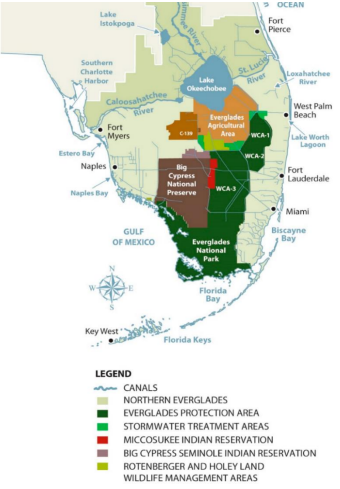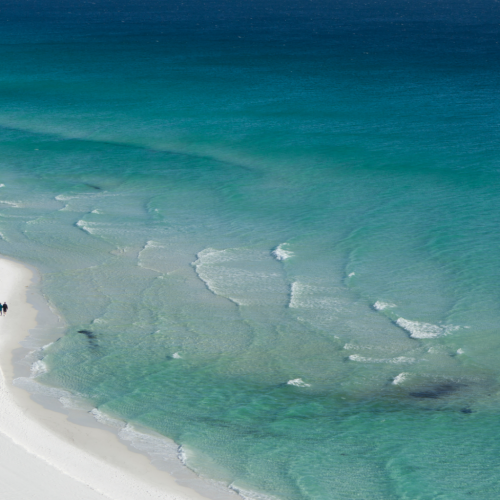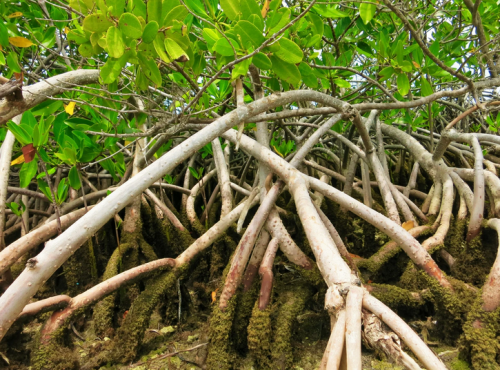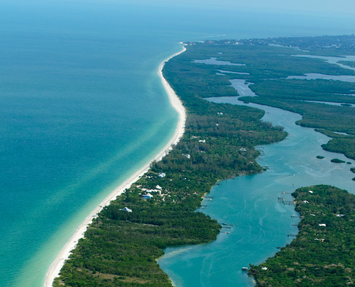With 8,436 miles of shoreline, 4 million acres of conservation land, and thousands of unique species of flora and fauna, many of which are federally endangered or threatened, Florida faces unique conservation challenges.
Several bills introduced in this session have the potential to affect some of the state’s most loved species and the habitats they depend on. Measures include enhanced state review of land changes within or near the Everglades Protection Area, establishing an Office of the Blue Economy, developing a seagrass restoration program, and designating the Brevard Barrier Island as an area of critical state concern. Many of these same ideas were proposed last session but died in various committees.
Here’s what this year’s habitats, biodiversity, and conservation legislation is all about:
- Everglades Protection Area
- Office of the Blue Economy
- Restoration of Osborne Reef
- Endangered and Threatened Species
- Mangrove Replanting and Restoration
- Seagrass Restoration Technology Development Initiative
- Designation of Brevard Barrier Island Area as Area of Critical State Concern
- Hunting and Fishing
- Other Related Bills
Everglades Protection Area
The Florida Everglades provides drinking water to more than 8 million people in the state of Florida, supports the state’s $1.2 billion fishing industry, and helps protect communities from natural disasters like hurricanes and floods. The 18,000 square mile wetland is also home to over 60 endangered species and is considered the largest surviving subtropical wilderness in the contiguous United States.

Two Everglades Protection Area bills — HB 175, introduced by Florida State Rep. Demi Busatta Cabrera (R), and SB 192, introduced by Florida State Sen. Bryan Ávila (R) — would create a two-mile “buffer” zone around the Everglades Protection Area and increase the level of review needed for changes to comprehensive plans on land within the protection area or the buffer zone.
Sen. Ávila told Florida Politics that SB 192 would “effectively prohibit the approval of small-scale development amendments for existing properties near the two-mile area.”
“We want to do our best to protect our unique habitats for future generations,” Ávila said.
The Everglades Protection Area is a large tract of land that encompasses the entirety of Everglades National Park, Arthur R. Marshall Loxahatchee National Wildlife Refuge, and a few other surrounding water conservation areas. This area was designated by the Everglades Forever Act in 1994 and has been the focus of a phosphorus reduction program.
“The present Everglades system has been subdivided by the construction of canals, levees, roads, and other facilities as part of efforts to drain the system for agriculture, development, and flood control,” the staff analysis for the bill stated. “As a result, the Everglades is less than half the size it was a century ago, and connections between the central Everglades and adjacent transitional wetlands have been lost.”
Miami Waterkeeper, a nonprofit that advocates for South Florida’s watershed and wildlife, voiced support for the legislation on its website stating, “if development consumes buffer lands and grows right to the very edge of the wilderness, the impacts would be unacceptable.”
Two similar bills were introduced in last year’s session, but died.
UPDATE: HB 175 died in Agriculture & Natural Resources Appropriations Subcommittee; SB 192 died in messages.
Office of the Blue Economy
Florida is the only state in the continental U.S. largely surrounded by coastal seas and oceans. Our state’s booming tourism and fishing industries are intrinsically linked to the health of our coasts. Florida State Rep. Kelly Skidmore (D) is looking to capitalize on this and emphasize the importance of the ocean in the state’s economy.
If passed, HB 527 would establish the Office of the Blue Economy within the state’s Department of Economic Opportunity. SB 1484, introduced by Florida State Sen. Jason Pizzo (D), would do the same. 
The bill defines the blue economy as the “economic uses of ocean and coastal resources with a focus on sustainable practices that benefit the long-term outlook of relevant industry sectors and the competitive positioning of the state in a global economy.” These industry sectors could include those related to boating, fishing, seafood farming and processing, diving, tourism, recreation, or any other industry that relies on ocean and coastal resources.
In addition to establishing an Office of the Blue Economy, this bill would also require the office to regularly publish Florida university-backed research related to the ocean and coasts that could be used by ocean-related businesses to make smarter decisions.
Last year, before the bill died in the 2022 legislative session, Skidmore told Florida Politics that the office would look out “for the economic health of the water, would care about its environmental health and work with those agencies to make sure that we’re doing all the right things.”
UPDATE: HB 527 died in the Regulatory Reform & Economic Development Subcommittee; SB 1484 died in the Commerce and Tourism Committee.
Restoration of Osborne Reef
In the 1970s, somewhere between 1 million and 2 million rubber tires were deposited off the coast of Broward County to create an artificial reef known as Osborne Reef. The goal of the project was to reduce landfill waste while providing a structure that coral could attach to, in hopes of creating the longest synthetic reef in the world. But over time, many of these tires have corroded and broken loose, harming marine life and causing damage to the existing nearby coral reef system.
Multiple tire retrieval projects have been attempted, including some conducted by Nova Southeastern University and the National Oceanic and Atmospheric Administration’s Marine Debris Program.
“Due to the magnitude and cost of such projects, however, most of the tires have not been removed,” reads the staff analysis for SB 546. As of August 2016, it is estimated that only 207,843 tires have been removed from this area.
SB 546, proposed by Florida State Sen. Bryan Ávila (R), would require the Department of Environmental Protection to submit a status report of the tire removal project and develop a restoration plan for the nearby reef once the tire cleanup is complete. Florida State Rep. Chip LaMarca (R) sponsored the coinciding house bill, HB 641.
“The original project has a tragic history,” Ávila told Florida Politics. “This project would initiate a plan to meet the initial intent, which was to create a vibrant reef for marine life to prosper in that body of water.”
UPDATE: SB 546 was laid on the table, meaning it was set aside and died at the end of the session — however, its contents were substituted by HB 641, which was enrolled, meaning it has been approved by both the House and Senate and sent to the Governor for approval.
Endangered and Threatened Species
Florida is home to hundreds of imperiled animal and plant species. According to the Florida Fish and Wildlife Conservation Commission, “imperiled species are fish and wildlife species that meet criteria to be listed as federally endangered, federally threatened, state threatened or Species of Special Concern.” The U.S. Fish and Wildlife Service has primary responsibility for those species that are federally endangered or threatened, but the FWC works in close partnership to help conserve them.
Additionally, states can have their own imperiled species classification and laws similar to the federal Endangered Species Act, according to the United States Geological Survey (USGS). This means that some species can have different threatened or endangered statuses at the federal and state levels.
Two identical bills, HB 1229, introduced by Florida State Rep. Daryl Campbell (D), and SB 1298, introduced by Florida State Sen. Shevrin Jones (D), would direct the FWC and the Florida Department of Agricultural and Consumer Services to continue to protect certain species, regardless of federal status.
“Notwithstanding declassification under the federal Endangered Species Act of 1973, the commission shall continue to protect species that meet the definition of endangered or threatened,” reads the bill text.
The bill also adds the language “including climate change,” as a factor to determine stressors facing threatened and endangered species. Additionally, the bill adds language that would prohibit the agencies from considering the economic cost of protecting a species when determining if it should be listed as threatened or endangered. Finally, the bill also adds a specific prohibition regarding the Florida panther, making it unlawful for people to kill a member of the endangered big cat species.
This legislation was introduced in last year’s session, but died.
UPDATE: HB 1229 died in the Agriculture, Conservation & Resiliency Subcommittee; SB 1298 died in the Environment and Natural Resources Committee.
Mangrove Replanting and Restoration
Florida has an estimated 600,000 acres of mangrove forests that contribute to the overall health and wellbeing of both the environment and people that live near the coast. In addition to being a sanctuary for threatened and endangered animals and a nursery for young marine animals, mangroves protect our shorelines from erosion and absorb storm surge impacts from hurricanes. Mangrove and other coastal wetland environments can also store carbon 10 times more efficiently than tropical forests. 
But human activities such as coastal development are destroying more mangrove forests worldwide than any other type of coastal habitat, says the FWC. According to a staff analysis of the bill, the Florida Marine Research Institute has reported up to 86% loss of mangroves in some areas of Florida since the 1940s.
Currently, mangroves in Florida are protected under the 1996 Mangrove Trimming and Preservation Act, which requires a permit from the Florida Department of Environmental Protection to alter or trim mangroves.
Two identical bills, SB 100 and HB 561, respectively introduced by Florida State Sen. Ileana Garcia (R) and Florida State Rep. Jim Mooney (R), would require the Department of Environmental Protection (DEP) to adopt rules for mangrove replanting and restoration.
These rules must help address erosion in areas of critical state concern, protect barrier and spoil islands, assist in Everglades restoration and Biscayne Bay revitalization, promote public awareness of the value of mangroves, and encourage local governments to create mangrove protection zones.
This legislation was introduced in last year’s session, but died.
UPDATE: SB 100 died in the Rules Committee; HB 561 died in the Agriculture, Conservation & Resiliency Subcommittee.
Seagrass Restoration Technology Development Initiative
Seagrasses are ecologically important and a vital part of marine ecosystems. They provide food and shelter for marine life, stabilize sediments and prevent erosion along the coastline, and increase water clarity. However, from 2011 to 2019, Florida lost about 58% of its seagrasses due to poor water quality, algal blooms, and extreme weather and heat. Another threat to seagrass is propeller scarring from boats, which causes damage that can take years to heal.
HB 1181, introduced by Florida State Rep. Will Robinson (R), would establish a Seagrass Restoration Technology Development Initiative within the Florida Department of Environmental Protection. A similar bill, SB 724, introduced by Florida State Sen. Jim Boyd (R), would do the same.
This bill directs the DEP, Mote Marine Laboratory and Aquarium, and the University of Florida to create a 10-year restoration plan for seagrass in Florida. The bill also calls for the establishment of an Initiative Technology Advisory Council to develop tools and technologies to aid in the sustainable restoration of seagrass.
“House Bill 1181 seeks to address (seagrass loss) and build upon a strong partnership between nursery restoration practitioners, top marine scientists, and our marine community to generate a source of genetically resilient and naturally reproducing Florida seagrass,” Robinson said in an interview with Florida Politics.
UPDATE: HB 1181 was laid on the table, meaning it was set aside and died at the end of the session — however, its contents were substituted by SB 724, which was passed and approved by the Governor.
Designation of Brevard Barrier Island Area as Area of Critical State Concern
The Brevard Barrier Island is one of the most fragile and endangered coastal ecosystems in North America. The island, which runs from Melbourne Beach down to the Sebastian Inlet, borders and helps protect the water quality and ecological productivity of the Indian River Lagoon.
island, which runs from Melbourne Beach down to the Sebastian Inlet, borders and helps protect the water quality and ecological productivity of the Indian River Lagoon.
The Brevard Barrier Island would join Big Cypress, Green Swamp, the Florida Keys, and Apalachicola Bay as an area of critical state concern under two similar bills, HB 1489 and SB 1686, introduced by Florida State Rep. Thad Altman (R) and Florida State Sen. Tom Wright (R).
“This part of the barrier islands is one of the most fragile and endangered coastal ecosystems in North America,” Altman said to the House Agriculture, Conservation, and Resiliency Subcommittee in March. “It’s the world’s largest aggregation of loggerhead sea turtles — largest nesting area of these very threatened species.”
The Areas of Critical State Concern program was established in 1972 and is “intended to protect resources and public facilities of major statewide significance, within designated geographic areas, from uncontrolled development that would cause substantial deterioration of such resources,” according to the Florida Department of Economic Opportunity.
“You look at a map and there’s very little green space on the barrier island now, except for the south beaches. The south beaches is a place that has a remnant of what it used to be like,” Altman said in an interview with WESH 2.
Other reasons for approving the designation of this area as an area of critical state concern listed in the staff analysis include:
- The Archie Carr National Wildlife Refuge is located within the barrier island. This refuge is one of the most critical areas for loggerhead sea turtle nesting in the world.
- The Indian River Lagoon, designated as an Estuary of National Significance by the U.S. Environmental Protection Agency in 1990, borders the western shore of the barrier island. The natural habitats of the barrier island ecosystem protect the water quality and productivity of the lagoon.
- The primary dune system of the barrier island provides the only protective buffer from storm surges associated with tropical storms and hurricanes.
UPDATE: SB 1686 was laid on the table, meaning it was set aside and died at the end of the session — however, its contents were substituted by HB 1489, which was enrolled, meaning it has been approved by both the House and Senate and sent to the Governor for approval.
Hunting and Fishing
Two identical joint resolutions, HJR 1157 introduced by Florida State Rep. Lauren Melo (R), and SJR 1234, introduced by Florida State Sen. Jason Brodeur (R), would amend the state constitution to preserve hunting and fishing as a public right in perpetuity. The legislation also specifies that this amendment does not limit the authority of the Florida Fish and Wildlife Conservation Commission given under Section 9 of Article IV of the State Constitution.
A joint resolution is the only authorized method by which the legislature may propose amendments to the State Constitution. If passed, the proposed amendment will appear on a statewide ballot for voter approval or rejection. It must pass each house by a three-fifths vote of the membership.
According to the Cornell Legal Information Institute, the phrase “in perpetuity” is a common legal term used to mean forever. This means that the joint resolution would establish hunting and fishing as a public right in the state constitution forever.
UPDATE: HJR 1157 was enrolled, meaning it has been approved by both the House and Senate and sent to the Governor for approval. SJR 1234 died in the Judiciary Committee.
Other Related Bills:
- Deepwater Port Dredging – HB 979 and SB 1072 (HB 979 died in the Infrastructure Strategies Committee; SB 1072 died in the Rules Committee)
- Photographic Evidence of Illegally Taken Wildlife, Freshwater Fish, and Saltwater Fish – SB 1044 (Died in the Environment and Natural Resources Committee)
- Venomous Reptiles – HB 1161 & SB 1266 (SB 1266 was laid on the table, meaning it was set aside and died at the end of the session — however, its contents were substituted by HB 1161, which was enrolled, meaning it has been approved by both the House and Senate and sent to the Governor for approval)
- Boating-restricted Areas – HB 1103 and SB 1314 (HB 1103 died in the Local Administration, Federal Affairs & Special Districts Subcommittee; identical SB 1314 died in the Community Affairs Committee)
- Outstanding Florida Springs – HB 1505 and SB 1134 (HB 1505 died in the Water Quality, Supply & Treatment Subcommittee; identical SB 1134 died in the Environment and Natural Resources Committee)